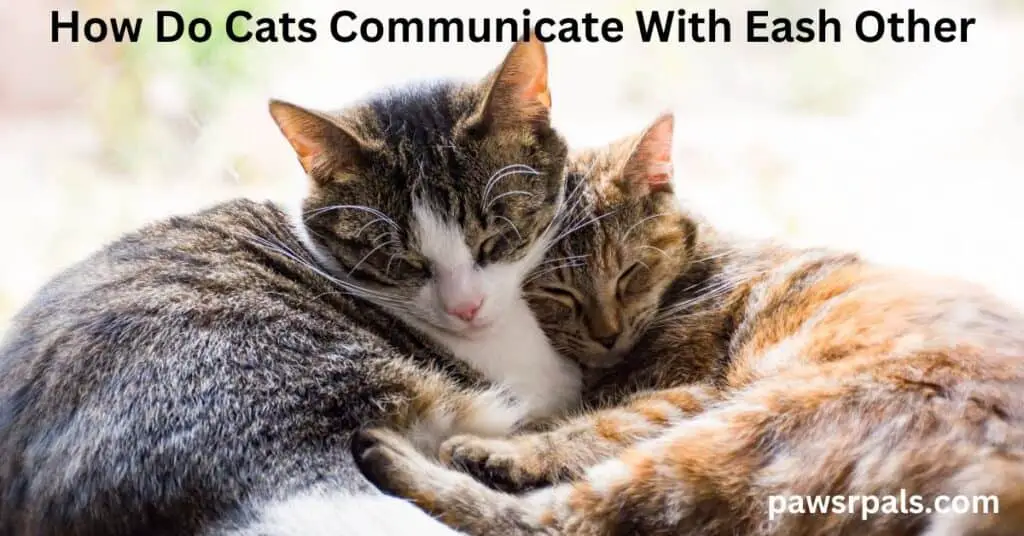Cats can’t talk to each other like humans do. So how do they communicate? You’ll be surprised that they chat with fellow felines quite a bit. They don’t do it the way we do.

Cats communicate with each other through a variety of physical, vocal, and chemical cues. Hissing means your cat is angry, while purring means your pet feels safe and at ease. Walking with a high tail signifies confidence, while turned-down ears mean friendliness.
A Cats Physical cues
Cats mostly communicate with each other using physical cues. These specific body movements may mean nothing to you but quite a lot to your feline friends.
A Cats High Tail Signifies Confidence
Your cat will hold its tail high if it feels friendly, confident, and calm. It’s sort of like how humans stand upright to emanate confidence.
Your cat might do this to establish dominance or to show that they’re at ease in the presence of another animal.
Cats Ears Turned Down Mean Friendliness
When your cat turns their ears down, it shows it is comfortable with the other cats’ presence. It doesn’t want the other cat to feel threatened or like it can’t approach it.
Exposing the Stomach Means the Cat is at Ease
A cat’s most vulnerable body part is its stomach. So whenever a cat does any movement that exposes its stomach, it shows that it doesn’t feel threatened and feels completely safe in whatever space.
A Cats Slow Blinking is a Green Light to Approach
Cats blink at each other to show them they are on friendly terms. If they’re physically super close and blink slowly, they affirm their affection for each other. Cats also show affection by rubbing their heads against one another.
If your cat blinks slowly at you, it’s telling you it likes you.
A Cat Crouching Down Indicates Fear
Cats crouch down when they’re getting ready to pounce on their prey. So if your pet is doing that, they either think they’re under threat and need to protect themselves or are preparing to attack another animal.
Either way, this can be a dangerous situation. Try to determine if there is an actual threat or your pet is playing around. You don’t need to interfere if it is the latter.
Cats Touching Noses is a Form of Greeting
Sometimes you’ll see your cats rub their noses. This nose touch is a way of greeting each other. Think of it as saying ‘hi’ or ‘good morning’ to a friend when you pass them.
Cats Vocal Cues
Cats use meows or trills to communicate with humans more than with other animals. They instinctively don’t meow. They have evolved to make this sound because it appeals to humans and makes them think cats are adorable. And they’re not wrong.
One meow from my cat, and I give him whatever he wants.
Even so, there are some instances where cats communicate with each other using vocal cues.
Cats Hissing Means Discomfort
The most common way cats talk to each other is through hissing. It is an unpleasant sound and usually means the cat is uncomfortable or angry. Either way, it is a sign for the other cat to stay away.
If you catch your cats hissing at each other, there is a good chance that they are about to fight. Intervention would be best because this isn’t a playful, friendly spat.
Cat Purring Indicates Happiness
Purring is the complete opposite of hissing. It signifies that your cat is happy, comfortable, and calm.
You might find your cats purring at each other when they’re cuddling or sleeping together.
If you hear one of your cats purring, leaving them be is best. They’re bonding, and anything that gets your pets to get along is good for the peace in your home.
Cat Howling is a Cry for Help
Cats sometimes howl when they’re in distress. They are calling out to a companion to help them escape whatever mess they’re in.
With house cats, this usually happens if a cat gets its nails stuck in a carpet or cloth. It also happens if a cat breaks a vase and wants its friend to come over before you do.
If you hear your cat howling, you should head to them and look at what is happening.
Cats Leave Chemical Cues Through Scent Marking
Cats mark their territory by depositing pheromones and oils from scent glands on their chins, paws, and cheeks. So if you see a cat rubbing against furniture, clothes, or people, they declare that those objects and people belong to them.
It is a sign for other cats to stay away. Cats will also urinate on objects and spaces to claim them as theirs.
This is more common among outdoor cats who urinate around the house or backyard to keep other cats away. However, domestic cats sometimes become territorial and start doing this too.
Final Thoughts on Cat Communication
Cats do adorable things, like rolling on the ground and rubbing heads with their siblings. Little did you know, each behavior pattern is a way for them to communicate something.
You can tell a lot about your cat by studying their behavior patterns, from whether they’re comfortable and safe in any given space to whether they need help and are under threat.
Before you go, you might find these articles helpful:

Leave a Reply